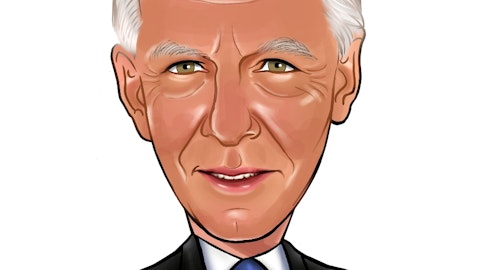Analog Devices, Inc. (NASDAQ:ADI) Q4 2023 Earnings Call Transcript November 21, 2023
Analog Devices, Inc. reports earnings inline with expectations. Reported EPS is $2.01 EPS, expectations were $2.01.
Operator: Good morning and welcome to the Analog Devices Fourth Quarter Fiscal Year 2023 Earnings Conference Call, which is being audio webcast via telephone and over the web. I’d now like to introduce your host for today’s call, Mr. Michael Lucarelli, Vice President of Investor Relations and FP&A. Sir, the floor is yours.
Michael Lucarelli: Thank you, Abigail and good morning everybody. Thanks for joining our fourth quarter fiscal 2023 conference call. With me on the call today are ADI’s CEO and Chair, Vincent Roche; and ADI’s Interim CFO, Jim Mollica. For anyone who missed the release, you can find it in relating financial schedules at investor.analog.com. On our disclosures, the information we are about to discuss includes forward-looking statements, which are subject to certain risks and uncertainties as further described in our earnings release and our periodic reports and other materials filed with the SEC. Actual results could differ materially from the forward-looking information. These statements reflect our expectations only as the call today.
We undertake no obligation to update these statements, except as required by law. Our references to gross and operating margin, operating and non-op expenses, tax rate, EPS and free cash flow will be on a non-GAAP basis, which excludes special items. When comparing our results to historical performance, special items are also excluded from our prior periods. Reconciliations of these non-GAAP measures to their most directly comparable GAAP measures and additional information about our non-GAAP measures are included in today’s earnings release. Two comments before we go prepared remarks. We adjusted our mapping to better align revenue to customer end markets. This resulted in slight changes to our end market mix with industrial increasing at each of the other markets slightly lower.
These changes are reflected on our web schedule in the quarterly results section for the last 3 years. And second, one more quick reminder, the first quarter of 2024 is a 14-week quarter. And with that, I’ll turn it over to ADI’s CEO and Chair, Vincent.
Vincent Roche: Thank you very much, Mike and a very good morning to you all. Though the industry is obviously moving through a more challenging period of the business cycle, I am very pleased to share that we are preserving the strength of our financial performance while preparing for the market’s recovery. Fourth quarter revenue was $2.7 billion, led by double-digit year-over-year growth in our automotive sector. The combination of careful expense management and our employees’ commitment to high standards of execution enabled us to deliver operating margins of 44.7% and EPS of $2.01 for the quarter. For the fiscal year, ‘23 again set new high watermarks with revenue reaching $12.3 billion, supported by all-time highs in the industrial and automotive sectors.
This resulted in EPS of $10.09 up 5% from a year ago. Notably, we returned a record $4.6 billion to shareholders in 2023, exceeding our 100% free cash flow return target. Since the closing of Maxim just over 2 years ago, ADI has returned roughly $12 billion to shareholders or nearly 15% of our market cap. Over the same time, we have reduced our share count by more than 6% and increased our dividend per share by 25%. Now looking to fiscal ‘24, the near-term dynamics remain uncertain. As you will recall, last quarter, we outlined a broad-based inventory correction across all markets and geographies, reflecting the deteriorating macro conditions and our improving lead times. Consistent with our view 90 days ago, we expect the customer inventory overhang to persist through the first half of the year.
Challenging times like these confirm the wisdom and the strength of our business model. The diversification of our business across customers, applications and products helps to limit volatility while preserving profitability. Building upon that foundation, we took actions to better ensure we can deliver operating margins in the low 40s and solid free cash flow despite the revenue decline. Importantly, however, we are not simply battening down the hatches. Our resilient financial model enables us to continue making the strategic investments necessary to allow us to capitalize on the upside when the business inflects higher. That longer term focus and commitment is why our customers have the confidence to increasingly depend on us as a key strategic partner.
I have been very heartened by my conversations with customers across many markets and geographies over this past quarter. Despite the near-term challenges, they share our optimism that the intelligent edge is enabling a future replete with opportunity, and they are clear about the expanding role that they expect ADI to play in their success. Our customers’ optimism is reflected in the continued expansion of our design win pipeline, which increased by double-digits again in 2023. That growth was enhanced by sustained momentum in our Maxim revenue synergies pipeline, which is tracking ahead of our initial expectations. We expect synergy-driven revenue acceleration in 2025 putting us on a path to achieve our goal of more than $1 billion in revenue synergy by 2027.
The combination of our strong design win growth with recurring revenue streams from our 75,000 product SKUs, which have average life spans of a decade or more creates a business with high barriers to entry that’s both resilient and rich with growth opportunities. Now, let me share some examples of recent wins with you. In Industrial Automation, we are increasingly delivering more complete solutions. At a top digital factory automation supplier, for example, we have recently leveraged our anchor position in software configurable I/O to attach additional solutions value across power, isolation and connectivity. As a result, we captured 3x the bill of materials and secured design wins across their entire platform. In Industrial Instrumentation, we have increased our design wins at SOC and memory test market leaders.
Our next-generation solutions increased channel density and throughput while reducing energy consumption by up to an incredible 30% per system. These are critical parameters for testing complex, high-performance compute GPUs and high-bandwidth memory for artificial intelligence systems. Looking now to automotive. In electrification, momentum continues for our wireless battery management system. This novel solution enables lower weight, greater scalability and improved manufacturing productivity, driving down the total cost of ownership for our customers while increasing ADI’s content. Last quarter, we secured our fifth customer, a top 10 EV OEM. We’ll begin to deploy our wireless solution in their next-gen EVs in 2026. Now furthermore, during the year, ADI reinforced our industry-leading position in automotive, high-performance functionally save power.
To that end, we won next-generation power for ADAS systems at four top suppliers this past year. These wins add another growth vector to our automotive franchise, which has benefited from strong momentum across electrification and in-cabin connectivity. This proliferation of ADAS is benefiting our high-speed GMSL connectivity portfolio. GMSL has been one of our fastest growing areas and a major revenue synergy generator for us. In the last year, we were awarded 4 new wins across leading North American, Asian and European OEMs. We are also expanding our opportunity and increasing our ROI, winning multiple design wins in industrial areas – in adjacent areas such as autonomous robotic systems. Our cloud infrastructure business is beginning to benefit from the power challenges and connectivity requirements necessary in AI ML systems.

Notably, a large hyperscaler designed our high-performance power and protection solutions into their next-generation AI platform. And in connectivity, systems are upgrading now to 1 terabit per second and require our highest level of precision control solutions to efficiently support the growth in data generation. In consumer, we won multiple power management sockets in a portable application and a key customer. These wins truly show the combinatorial power of our acquisition strategy. We leveraged our industry leading cell and switcher, Maxim’s cost optimized process technology, and our customer relationships to secure these wins. And lastly, in healthcare, Maxim strengthened our comprehensive suite of technology for personal monitoring solutions, adding sensor AFEs, microcontrollers and ultra-low power technologies.
We secured a design win at a leading continuous glucose monitoring customer this year. Our solution increases the robustness, accuracy and power efficiency of their glucose center, thereby helping to extend its life from days to weeks. So in summary, we’re proud of another year of record revenue and earnings. We continue to demonstrate the power of our business model, which delivers results through all phases of the business cycle. Our continued strong investments in technology and business innovation, customer engagement, and our hybrid manufacturing model positions ADI and our customers to take maximum advantage of the opportunities at the intelligent edge when the business recovery arrives. Now I’d like to pass the call over to Jim. Over the past 35 years, Jim has taken on a number of critical financial leadership roles across ADI, enabling him to develop a breadth and depth of understanding of our business that very, very few possess.
So I’m pleased now to have him on my leadership team and to be joined by Jim on today’s call. Over to you, Jim.
Jim Mollica: Thank you for that introduction, Vince, I’m excited to be here today, and let me add my welcome to our fourth quarter earnings call. Starting with a brief recap of fiscal 2023 results. Revenue increased 2% to $12.3 billion, marking ADI’s third consecutive record year. Gross margin of 72.5% moderated from last year’s record results of 73.6%. Operating margin of 48.9% decreased 50 basis points, roughly half the decline of gross margin, reflecting strong operating expense control. All told, EPS increased 5% to a record $10.09. Now moving to fourth quarter results. Revenue of $2.72 billion declined 12% sequentially and 16% year-over-year, finishing above the midpoint of our outlook despite the challenging operating environment.
Industrial represented 50% of quarterly revenue, declining 19% sequentially and 20% year-over-year. As expected, we experienced broad-based weakness as inventory adjustments continued across our diverse customer base. For the full year, Industrial increased 6%, achieving its third straight record result with strength across instrumentation, test, energy and aerospace and defense. Automotive, which represented 27% of quarterly revenue was down slightly sequentially and up 14% year-over-year, marking 12 straight quarters of double-digit growth. For the year, Automotive also achieved its third straight record result, increasing 19%, with strong growth across our functionally safe power, battery management and in cabin connectivity solutions. Collectively, these were up more than 30%.
Communications, which represented 13% of quarterly revenue, declined 6% sequentially and 32% versus a record fourth quarter 2022. For the year, Communications decreased 13%, with steeper declines in wireless versus wireline. And lastly, Consumer represented 11% of quarterly revenue, down 6% sequentially and 28% year-over-year. Consumer decreased 20% in fiscal 2023, driven by industry-wide weaker demand and ongoing inventory corrections. Now on to the rest of the P&L. Fourth quarter gross margin was 70.2%, down sequentially and year-over-year driven by unfavorable product mix, lower factory utilizations and lower revenue. OpEx in the quarter was $692 million, down $60 million sequentially. These significant savings were driven by disciplined expense management and lower variable compensation.
As a result, operating margin came in at the higher end of our outlook of 44.7%. Non-op expense finished at $65 million and the tax rate for the quarter was 12.5%. All told, EPS was $2.01, slightly above our outlook. Now on to the balance sheet. We ended the quarter with approximately $1 billion of cash and cash equivalents and a net leverage ratio of 0.9x. Inventory decreased nearly $70 million sequentially, driven by finished goods. Channel inventory also declined as we actively manage sell-in to be less than sell-through. Given lower revenue, inventory days increased to 188 and channel weeks ticked up slightly, ending within our target range of 7 to 8 weeks. Now moving on to our cash flow items. Operating cash for the quarter and the year was $1.2 billion and $4.8 billion, respectively.
CapEx for the quarter was $476 million and for fiscal 2023 was $1.3 billion. These CapEx numbers are gross figures, which do not include the benefits of the investment tax credits or grants related to both the U.S. and European Chips Act. Full year free cash flow was $3.6 billion or 29% of revenue. During the year, we returned 130% of free cash flow via roughly $3 billion in share repurchases and $1.7 billion in dividends. Now moving on to the guidance for the first quarter, which will be on a 14-week basis. First quarter revenue is expected to be $2.5 billion, plus or minus $100 million. Once again, we expect sell-through to be higher than sell-in. At the midpoint, we expect all end markets to be down sequentially. Industrial is expected to be down the most, followed by Consumer and Comms with Automotive faring the best.
Operating margin is expected to be 41.5%, plus or minus 70 basis points. Our tax rate is expected to be 11% to 13%, and based on these inputs, adjusted EPS is expected to be $1.70 plus or minus $0.10. I will conclude my remarks with a brief update on the current operating backdrop. As Vince mentioned, we continue to see broad-based weakness across markets and geographies as customers work to reduce inventory and a stressed macro backdrop. Importantly, our lead times are now back to normal levels with 95% of our products shipping within 13 weeks, given our customers high confidence and timely supply. Encouragingly, during the fourth quarter, we’ve seen cancellations fall and bookings stabilize. This gives us greater confidence that the ongoing inventory correction will taper through the first half of the fiscal year.
As we discussed last time, we’ve taken actions to preserve the integrity of our income statement, our balance sheet and our cash flow statements. Let me provide an update in these areas. We are once again lowering internal utilizations with a goal of significantly reducing inventory in the first half of the year. Our hybrid manufacturing model and ability to swing in external wafers will help us moderate the decline in factory starts. The unique ability positions us to deliver healthy gross margins despite the significant revenue decline from a year ago. Given the enhancements made to our hybrid manufacturing model over the last 2 years, we now plan to slow the expansion of our internal fabs and back-end facilities. As a result, we expect 2024 CapEx to be between $600 million and $800 million or down about 45% versus 2023.
Importantly, this CapEx reduction does not compromise our long-term growth or resiliency efforts that gives customers multiple locations to source ADI supply. And lastly, we took additional steps to structurally reduce our OpEx. These actions, combined with lower variable comp and seasonally lower spend in the first quarter will result in a slight decline in OpEx sequentially even with the extra week. So in closing, our ability to generate operating margins in the low 40s, which were our previous highs in the last cycle demonstrates the durability of this franchise and how we’ve enhanced our operating model over time. And with that, I’ll give it back to Mike for Q&A.
Michael Lucarelli: Thanks, Jim. Welcome to the call. It’s great to have you. Now let’s get to the Q&A session. [Operator Instructions] With that, we will have our first question please.
See also 25 Countries with the Most Handsome Men in the World and Healthiest Food in the World: Top 20 Countries with the Healthiest Diets.
Q&A Session
Follow Analog Devices Inc (NASDAQ:ADI)
Follow Analog Devices Inc (NASDAQ:ADI)
Operator: Thank you. [Operator Instructions] Our first question comes from Ambrish Srivastava with BMO. Your line is open.
Ambrish Srivastava: Hi, thank you. Thank you very much for taking my question. Vince, it looks like order has been restored in the diversified Analog world with – it looks like a very normal cyclical downturn and with you, what you’ve built is a structurally more profitable company holding to 40% – low 40% operating margin line. My question is on a bottoming process. And I know we’re not there yet, but can you just remind us or help us understand metrics you’re following regarding cancellations, pushouts, backlog, you did talk about cancellations, Jim. And then kind of related to that, is if you look at past cycles, does automotive needs to go down double-digit year-over-year decline as industrial has been there? And how should we think about that? Thank you.
Vincent Roche: Yes. God morning, Ambrish, and thank you for the question. So yes, we noted last quarter that we believe the inventory digestion issue would last two to three quarters. And I’d say, given the new information that we have, our conviction of that has actually grown. We have, through careful analysis and observation, we’ve seen inventory digestion accelerate at our largest direct customers across the board and across all the various segments that we support. And we’re continuing to reduce our channel inventories as well. So I think very encouragingly, even with normalized lead times, as we’ve said, we’re shipping that kind of 95% of customer requests within a quarter, which is very, very normal. We saw against that backdrop, a sharp drop in cancellations, and though the book-to-bill was below unity in the fourth quarter.
We did see our bookings improve sequentially. So that gives us a lot of confidence as to what’s going on. Regarding Automotive, I’m not sure, by the way. The automotive – the assumption you’re making is that there could be a double-digit drop in Automotive. I’m not sure about that because we know that cars are consuming about 10% more silicon per year. And in fact, we continue to grow in share and ASP in the car. So my own sense is that against what could be a very challenging macro backdrop during 2024, that of all the elements of our portfolio, automotive, we expect will fare best of them all. And we still have pretty strong confidence that we’ll grow in 2024.
Ambrish Srivastava: Thank you, Vince.
Michael Lucarelli: Thanks, Ambrish. Next question please.
Operator: [Operator Instructions] Our next question comes from Vivek Arya with Bank of America Securities. Your line is open.
Vivek Arya: Thank you for taking my question. Vince, I’m trying to reconcile the comments that were made about some stabilization in bookings. That sounds like a positive. But I think in the prepared remarks, you also said some headwinds that could persist through the first half of the fiscal year, suggesting that April could be a sub-seasonal quarter. So I know you’re not guiding specifically out to April, but what is the right way to look at the puts and takes as we think about April? Can it be seasonal, whether it not be seasonal? And also this extra week from January, did that really give you that 7.5% push, so we should be taking that out of April. So any way to help us give us a sense for how the April could shape up would be very helpful. Thank you.
Vincent Roche: Yes. Well, I think it’s – Vivek, thank you for the question. It’s one quarter at a time here. What I will say contextually is that we expect the inventory overhang to have been depleted by the start of our third quarter, which is in May of next year. So, we still remain pretty confident about that, given the dynamics that I just outlined. But the other parts of the cycle that we’re really – I think everybody is seeing pressure from is the macroeconomic climate and particularly the decline of semi business in China. So that’s the piece. I mean that is the piece that isn’t well understood. But all that said, the macro will be the governor on what happens in the second half of the year. And I think another quarter or so will give us a lot more confidence in terms of what is possible in the second half. But I will let Jim answer as well give you some particular statistics to underpin our assumptions here.
Jim Mollica: Thanks, Vince. Yes, let me just speak to – let me unpack lead times a bit first. As we said, lead times are now kind of back to where they were, 95% of our products are shipping within 13 weeks. And we’ve seen steady improvement in lead times in both 3Q and 4Q. And I guess from the refreshing side of that is from a customer viewpoint, customers have now adjusted to those shorter lead times. And our order rates basically in the fourth quarter basically stabilized in fact, picked up in 4Q versus 3Q. So that’s good news for us as the customers have shopped and their signal into us. As Vince said, our book-to-bill will still be low on there, but it is kind of the first lines there. Additionally, cancellations in the fourth quarter were down meaningfully for the first time and probably close to a year.
And cancellations on a shorter time fence were also very, very low. So that’s good for us. From a channel perspective, we’re being cautious. We continue to basically ship into the channel less than our sell-through, which basically will position us well for when the upswing occurs. And from an end market viewpoint, let me just close on that point. All markets in 1Q will be down on a quarter-to-quarter basis. Yes, that’s it. Mike, anything else?





